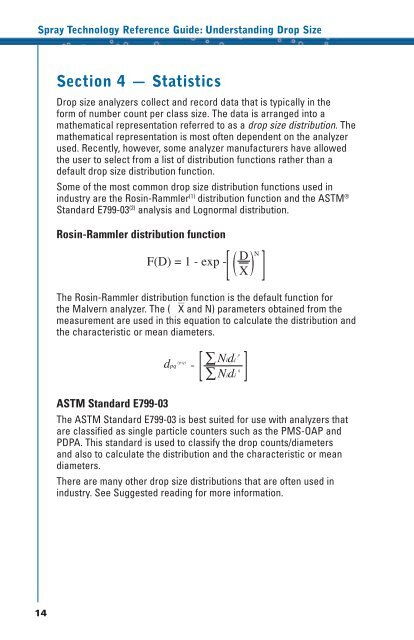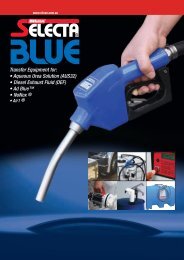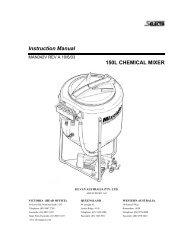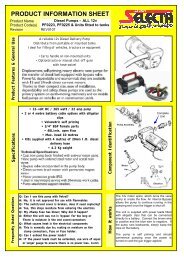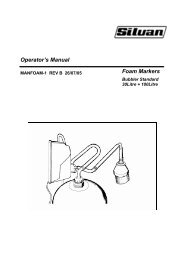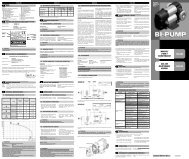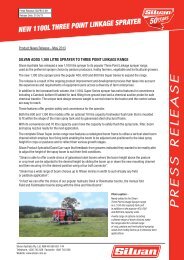Spray Technology Reference Guide: Understanding Drop ... - TeeJet
Spray Technology Reference Guide: Understanding Drop ... - TeeJet
Spray Technology Reference Guide: Understanding Drop ... - TeeJet
Create successful ePaper yourself
Turn your PDF publications into a flip-book with our unique Google optimized e-Paper software.
<strong>Spray</strong> <strong>Technology</strong> <strong>Reference</strong> <strong>Guide</strong>: <strong>Understanding</strong> <strong>Drop</strong> Size<br />
Section 4 — Statistics<br />
<strong>Drop</strong> size analyzers collect and record data that is typically in the<br />
form of number count per class size. The data is arranged into a<br />
mathematical representation referred to as a drop size distribution. The<br />
mathematical representation is most often dependent on the analyzer<br />
used. Recently, however, some analyzer manufacturers have allowed<br />
the user to select from a list of distribution functions rather than a<br />
default drop size distribution function.<br />
Some of the most common drop size distribution functions used in<br />
industry are the Rosin-Rammler (1) distribution function and the ASTM ®<br />
Standard E799-03 (2) analysis and Lognormal distribution.<br />
Rosin-Rammler distribution function<br />
( )<br />
N<br />
D<br />
X<br />
F(D) = 1 - exp -<br />
[ ]<br />
N<br />
D<br />
( X )<br />
The Rosin-Rammler distribution function is the default function for<br />
the Malvern analyzer. The ( ⎺X and N) parameters obtained from the<br />
measurement are used in this equation to calculate the distribution and<br />
the characteristic or mean diameters.<br />
F(D) = 1 - exp -<br />
[ ]<br />
(p-q)<br />
dpq =<br />
(p-q)<br />
dpq =<br />
[<br />
<br />
]<br />
Nidi p<br />
Nidi<br />
<br />
q<br />
Nidi p<br />
Nidi q<br />
[ ]<br />
ASTM Standard E799-03<br />
D<br />
The ASTM Standard E799-03<br />
V0.9 - D<br />
is best suited V0.1<br />
for use with analyzers that<br />
are classified as single particle D Dcounters V0.5<br />
V0.9 - D V0.1 such as the PMS-OAP and<br />
PDPA. This standard is used to Dclassify V0.5<br />
the drop counts/diameters<br />
and also to calculate the distribution and the characteristic or mean<br />
diameters.<br />
There are many other drop size distributions that are often used in<br />
industry. See Suggested reading for more information.<br />
14


